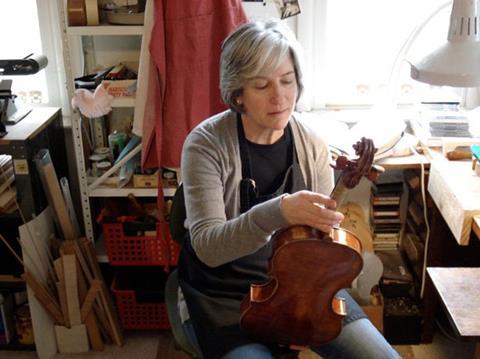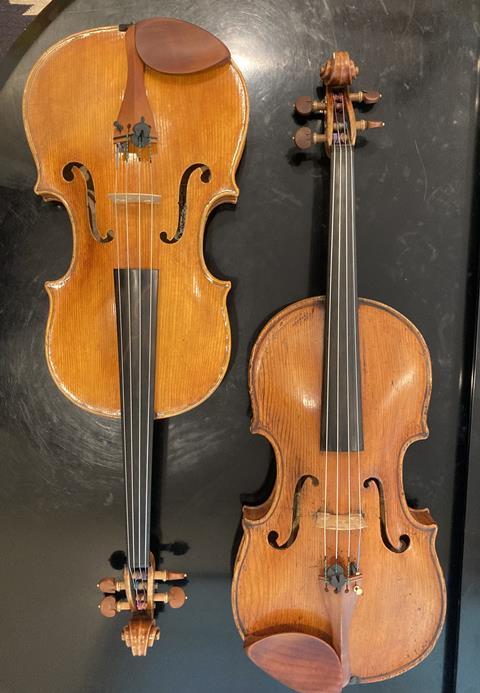The maker shares why she has dedicated her craft to the viola, as we take a close-up look at her copy of a 1787 Castello viola commissioned by National Symphony Orchestra principal violist Daniel Foster

Discover more lutherie articles here
’You don’t make it with your hands, you form it with your hands. You make it with your mind’
Luthier Gabriele Kundert shares this quote attributed to visual artist Edgar Tolson from 1971. She applies it to her work, which sees her specialising in solely making violas. Why does Kundert specialise in viola lutherie specifically, and when did she begin to explore this avenue of work?
’The viola caught my interest from the beginning of my career,’ Kundert says. ’The violin is much more standardised than the viola which has a wide range in size. There is more room for experimentation on patterns.’ Additionally, she noted the dearth of beautiful antique violas compared with violins. ’As a new maker, I have been able to fill part of that void.’
Specialising in viola making presents its unique challenges, in that playing an instrument that is longer, heavier and with an increased string length for the fingers can lead to more injuries in violists than violinists.
’The violinist needs to twist the upper body somewhat and the shoulders and arms to play music.’ Using this technique, along with a larger instrument such as a viola, ’well, you get injuries,’ she says. ’No one even wants to talk about how painful these can be and how a career can depend on being able to play a lifetime.’
Kundert says it’s crucial to harness the non-standardised sizing of violas in order to accommodate individual players. ’Over the years, I have found it important to find models of violas or even downsize models to accommodate violists.
’I had no formal training in this area. It was a matter of communicating with violists and experimenting to find suitable body lengths, body widths and string lengths to come up with several patterns that I believe work well. I took measurements and notes of every viola that entered my shop and tracings as well. I came up with some measurements that I thought worked tonally as well. I listened a lot!’
Kundert says the most surprising thing she discovered was how differently each player sounded, even on the same viola.
She has been asked to make numerous customised violas based on old models, including Bill Foster’s copy of his Vuillaume viola, Manuel Diaz’s copy of a Rivolta viola, Denise Wilkinson’s copy of her Gagliano viola and Roberto Diaz’s copies of his violas by Tononi, Camilli and the ‘Primrose’ Amati.

Additionally, for Daniel Foster, principal viola of the National Symphony Orchestra, Kundert made a copy of his 1787 Castello viola. Why did Foster want a copy of a viola he already owned?
’For me the purpose of having a second instrument which was a copy of my first instrument had to do with playability rather than sound,’ said Foster. ’I wanted to be able to switch easily back and forth between the two without having to make adjustments technically and set-up wise.’
’Of course, even though the plan was to for the most part match the dimensions, one never knows whether subtleties like response, resonance, evenness between the strings will be copied. So I was thrilled to find that playing the way I normally did on my Castello worked just the same on my new Kundert. It was actually a big relief, because you never know.
’As for the sound, which to me is the greatest mystery, well, the Kundert sounds like a Kundert! For the life of me I don’t understand how that works, but Gabrielle’s sound is somehow always there, just in the same way that I still sound like me when I play on different instruments.’
Kundert describes the instrument as ’a lovely looking viola, with a charm to its design and sound. It suits Daniel so well and seems a part of him too. I associate the sound of that viola with Daniel. I’m so grateful that I was chosen to make the copy for him!’
Read: Why we should all be violists
Read: From Stradivari to Zygmuntowicz: the instruments of Music@Menlo
Discover more lutherie articles here
An exclusive range of instrument making posters, books, calendars and information products published by and directly for sale from The Strad.
The Strad’s exclusive instrument posters, most with actual-size photos depicting every nuance of the instrument. Our posters are used by luthiers across the world as models for their own instruments, thanks to the detailed outlines and measurements on the back.
The number one source for a range of books covering making and stringed instruments with commentaries from today’s top instrument experts.
American collector David L. Fulton amassed one of the 20th century’s finest collections of stringed instruments. This year’s calendar pays tribute to some of these priceless treasures, including Yehudi Menuhin’s celebrated ‘Lord Wilton’ Guarneri, the Carlo Bergonzi once played by Fritz Kreisler, and four instruments by Antonio Stradivari.






































No comments yet